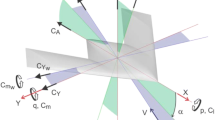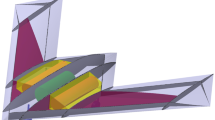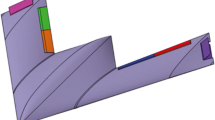Abstract
Extensive experimental and numerical investigations on a highly swept generic unmanned combat aerial vehicle (UCAV) configuration of lambda type with a variable leading edge contour have been conducted. Within these investigations, it was shown that the flow field is dominated by complex vortex systems including vortex-to-vortex and vortex-to-boundary layer interactions. The vortex-dominated flow field has a strong nonlinear influence on the aerodynamic behavior of the configuration. Hence, controllability is demanding and poses a real challenge in the design of these kinds of configurations. Especially, the dimensioning of the control surfaces, for the lateral- and longitudinal stability of tailless configurations of low aspect ratio and high leading-edge sweep, poses a challenging task which is not yet solved. To understand the problem of lacking lateral- and longitudinal stability for these kinds of configurations, experiments in the subsonic and transonic flow regime have been conducted for the Stability and Control Configuration (SACCON), which has a leading edge sweep of 53°, to assess the control surface effectiveness of conventional trailing-edge control devices. The present study reviews the experimental investigations conducted with the highly swept generic UCAV configuration SACCON.













Similar content being viewed by others
Abbreviations
- AVT:
-
Applied Vehicle Technology
- B:
-
Wing span [m]
- CL :
-
Lift coefficient [–]
- CD :
-
Drag coefficient [–]
- CY :
-
Side force coefficient [–]
- Cl :
-
Rolling moment coefficient [–]
- Cm :
-
Pitching moment coefficient [–]
- Cn :
-
Yawing moment coefficient [–]
- CFD:
-
Computational fluid dynamics
- CS:
-
Control surface
- cref :
-
Reference chord length [m]
- cr :
-
Root chord [m]
- cMRP :
-
Chord length location of MRP [m]
- DNW:
-
German–Dutch Wind Tunnels
- L.E.:
-
Leading edge
- LIB:
-
Left-hand inboard
- LOB:
-
Left-hand outboard
- M:
-
Mach number [–]
- MPM:
-
Model positioning mechanism
- MRP:
-
Moment reference point
- NATO:
-
North Atlantic Treaty Organisation
- NWB:
-
Low-Speed Wind Tunnel Braunschweig
- PSP:
-
Pressure-sensitive paint
- RANS:
-
Reynolds-averaged Navier–Stokes
- Re:
-
Reynolds number, based on cref [–]
- RIB:
-
Right-hand inboard
- ROB:
-
Right-hand outboard
- RTO:
-
Research and Technology Organization
- S:
-
Wing half-span [m] = 0.5 b
- SACCON:
-
Stability and Control Configuration
- STO:
-
Science and Technology Organization
- TWG:
-
Transonic Wind Tunnel Göttingen
- UCAV:
-
Unmanned combat aerial vehicle
- RHS :
-
Full-span deflection right-hand side
- LHS :
-
Full-span deflection left-hand side
- x, y, z:
-
Coordinate system
- α:
-
Angle of attack [°]
- η:
-
Control surface deflection angle [°]
References
Vicroy, D.D., Huber, K.C., Löser, T., Rohlf, D.: “Low-speed dynamic wind tunnel test analysis of a generic 53° swept UCAV configuration with controls”, 32nd AIAA applied aerodynamics conference, AIAA-2014-2003. Atlanta, GA (2014)
Schütte, A., Huber, K.C., Zimper, D.: “Numerische Aerodynamische Analyse und Bewertung einer agilen hoch gepfeilten Flugzeugkonfiguration,” Deutscher Luft- und Raumfahrtkongress, Rostock, 22–24 Sep 2015
Cummings, R.M., Schütte, A. et al.: “Assessment of stability and control prediction methods for nato air and sea vehicles,” NATO RTO/AVT, final report of the AVT-161 task group, RTO-TR-AVT-161, September 2012
Huber, K. C., Schütte, A., Rein, M.: “Numerical investigation of the aerodynamic properties of a flying wing configuration,” 30th AIAA Applied Aerodynamics Conference, AIAA -2012-3325, 2012
Schütte, A., Hummel, D., Hitzel, S.M.: Flow physics analyses of a generic unmanned combat aerial vehicle configuration. J. Aircr. 49(6), 1638–1651 (2012)
Schütte, A., Hummel, D., and Hitzel, S.: “Numerical and experimental analyses of the vortical flow around the SACCON configuration”, 28th AIAA Applied Aerodynamics Conference, AIAA-2010-4690, Chicago, IL, June 2010
Website of the german dutch wind tunnels: http://www.dnw.aero/wind-tunnels/nwb.aspx (2014). Accessed 14 May 2014
Rein, M., Höhler, G., Schütte, A., Bergmann, A., Löser, T.: Ground-based simulation of complex maneuvers of a delta-wing aircraft. J. Aircr. 45(1), 286–291 (2008)
Bergmann, A., Huebner, A., Löser, T.: Experimental and numerical research on the aerodynamics of unsteady moving aircraft. Prog. Aerosp. Sci. 44(2), 121–137 (2008)
Huber, K., Vicroy, D.D., Schütte, A., and Hübner, A.-R.: “UCAV model design investigations and static low speed wind tunnel experiments to estimate control device effectiveness and S&C capabilities,” 32nd AIAA Applied Aerodynamics Conference, AIAA-2014-2002, Atlanta, GA, June 2014
Löser, T., Vicroy, D.D., Schütte, A.: “SACCON static wind tunnel tests at DNW-NWB and 14′ × 22′ NASA LaRC”, 28th AIAA Applied Aerodynamics Conference, AIAA-2010-4393, Chicago, IL, June 2010
Rein, M., Gardner, A. D., Rütten, M.: “Study of the influence of a highly integrated flow-through intake on compressible flows about the lambda wing configuration SACCON,” 30th AIAA Applied Aerodynamics Conference, AIAA-2012-3324, New Orleans, LA, June 2012
Rein, M., Gardner, A.D.: Generic lambda wing configuration in compressible flow: effect of highly integrated intakes. J. Aircr. 52(3), 972–980 (2015)
Rütten, M., Saalfeld, B., Rein, M., Künemund, J., and Saalfeld, S.: “Numerical flow investigation of morphing leading edges for the enhancement of maneuverability of unmanned combat air vehicles,” 30th AIAA Applied Aerodynamics Conference, AIAA-2012-3326, New Orleans, LA, June 2012
Rein, M., Irving, J., Rigby, G., and Birch, T.: “High speed static experimental investigations to estimate control device effectiveness and S&C capabilities,” 32nd AIAA Applied Aerodynamics Conference, AIAA-2014-2004, Atlanta, GA, June 2014
Zimper, D., Rein, M.: “Experimental and numerical analysis of the transonic vortical flow over a generic lambda wing configuration,” 32nd AIAA Applied Aerodynamics Conference, AIAA-2014-2005, Atlanta, GA, June 2014
Vicroy, D.D., Löser, T., Schütte, A.: Static and forced-oscillation tests of a generic unmanned combat air vehicle. J. Aircr. 49(6), 1558–1583 (2012)
Paul, M.C., Rütten, M., Rein, M.: “Experimental and numerical investigations on unconventional control concepts for agile and highly swept aircraft configurations,” Deutscher Luft- und Raumfahrtkongress, Rostock, 22–24 Sept 2015
Author information
Authors and Affiliations
Corresponding author
Additional information
This paper is based on a presentation at the German Aerospace Congress, September 22–24, 2015, Rostock, Germany.
Rights and permissions
About this article
Cite this article
Huber, K.C., Schütte, A., Rein, M. et al. Experimental aerodynamic assessment and evaluation of an agile highly swept aircraft configuration. CEAS Aeronaut J 8, 17–29 (2017). https://doi.org/10.1007/s13272-016-0219-y
Received:
Revised:
Accepted:
Published:
Issue Date:
DOI: https://doi.org/10.1007/s13272-016-0219-y




